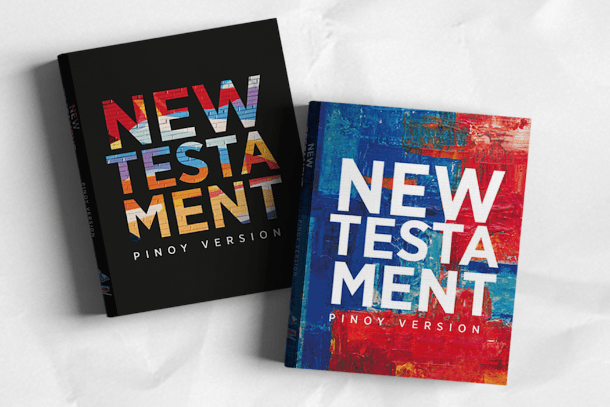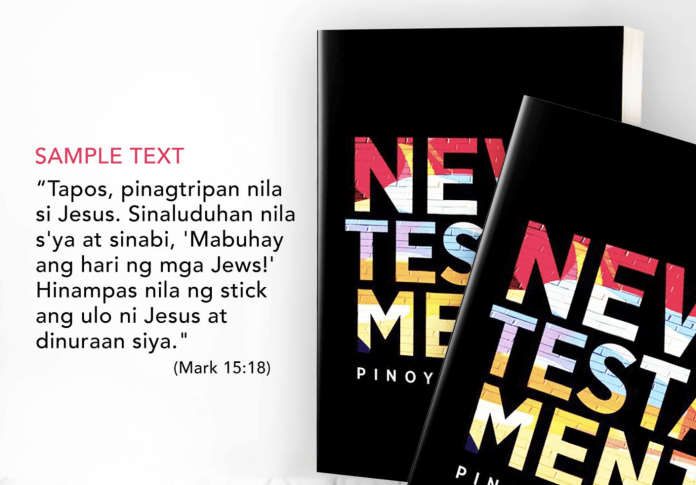A new translation of the Bible’s New Testament continues to attract the attention of Filipinos two years after its launch in 2018.
The translation uses what its publishers described as “heterogenous language,” which is characterized by a mix of Filipino and English.
On his way to work in Manila, Ray Haigler saw a copy of the “New Testament Pinoy Version” on a bookstore’s display window.
For someone born and raised Catholic, Ray is used to reading the Bible, but he was curious seeing a “new version” being marketed.
“I wondered what made it ‘Pinoy,’ and when I finally got to read it, I was surprised by the text and how it was colored by a sense of humor,” he said.
Galatians 1:6, for instance, Saint Paul rebuked unfaithful Christians, saying: “Sobrang nashock ako sa inyo. Ang dali nyo namang tinalikuran ang Diyos. Imagine, sobrang bait nya at pinadala nya si Christ sa atin. Ang Diyos mismo ang pumili sa inyo, tapos ngayon, inentertain nyo ang ibang gospel?”
Making the Bible easy to understand
The “New Testament Pinoy Version” is an official translation released by the Philippine Bible Society.
In recent weeks, comments about the new translation came out on social media after bookstores promoted it online.
Some netizens noted the translation’s “lack of formality” while others were “glad” of the “new version.”
“[The new translation] made it easier for many Filipinos, especially the working class, to really understand the text as it communicates to them in their own language,” said Ray.
He said that reading the new translation “actually gave me a deeper understanding of the truth of God’s words.”
“The truth, regardless of the translation, will always show and it will always lead us to the pure teaching of Jesus Christ,” he said.
Bishop Sofronio Bancud of the Episcopal Commission on Biblical Apostolate, clarified that the “New Testament Pinoy Version” of the Bible is no different from the “classic version.”
“There’s no difference,” he said, adding that “the sole purpose of the translation is to reach out to the younger generations.”
The prelate said that through the new version, young people “may be able to hear, understand, and better appreciate, then reflect on the Word of God”.
Anicia Del Corro, a linguist and translation consultant of the Philippine Bible Society, said the “incomprehensibility” of the traditional translation has become an excuse for young people not to read the Bible.
She said the new translation uses language that way most Filipinos speak it. “If you make it any different from the way they naturally speak, they won’t read it,” she said.

Spreading the Good News
It seems that not only young Filipinos are enjoying the Bible.
A Filipino Christian community in Japan found it helpful in spreading the Good News.
In 2018, when young pastor Jose Santos was assigned full-time pastor at Lifegiver Church in Chiba, Japan, he struggled to make people understand the message of the Bible.
“My references were either formal English or traditional Filipino that even I couldn’t understand,” he said.
At night, Jose would take extra time to study and translate the Bible in a conversational way.
“In our Church, most of our members are Filipino working class. Since they have stayed in Japan for so long, they find it hard to really understand English and even Filipino,” he said.
Then he heard about the “New Testament Pinoy Version” and requested a friend to bring a copy to Japan.
“I immediately went to the controversial verses to see and read it for myself. Honestly, I was shocked by the words used, but as I continued, I noticed it didn’t veer away from the context,” he said.
“In a way, it was easier for me to understand, and at the same time, on how I would explain it to other people,” added Jose.
He noted that the Bible has always been translated using the “lingua franca” of a particular generation, or in a language of a particular group of people or their nationality.”
Del Corro said the Pinoy Version was 14 years in the making.
Next in line are translation of the Psalms and the Proverbs, and eventually the Old Testament.
On September 30, the world marks International Translation Day, also the Feast Day of St. Jerome, the Bible translator who is considered patron of translators.









